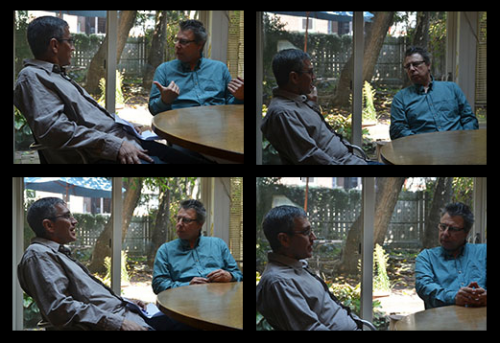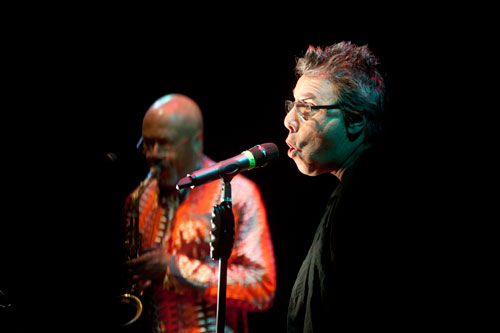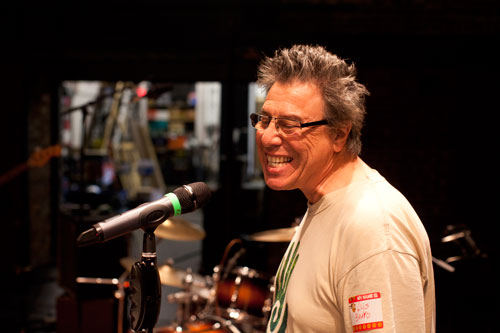The Staging of Poetry’s Voice: An interview with Poet Luis Bravo
by Israel Centeno / January 31, 2013 / No comments

Venezuelan writer Israel Centeno (left) interviews Uruguayan poet Luis Bravo (right). Photos: Camila Centeno.
Luis Bravo is one of the most prominent Uruguayan poets in recent decades. His poetry is conceived so that voice and performance assume the same artistic importance as the written word, and transcend the page. He insists emphatically that his work goes beyond performance or mise en scène, to what he prefers to call “staging of poetry’s voice,” or mise en voix.
In early September, Bravo was in Pittsburgh to take part in City of Asylum/Pittsburgh’s annual Jazz Poetry Concert. A day before the event, he was interviewed by Venezuelan writer Israel Centeno. In this informal conversation, the two writers reflect on some key elements in the discussion on contemporary literature: The distinction between the oral and written word, the poet’s social and political commitment, and the impact that new technology has had on both writers and readers.
To start, I’d like you to tell us about yourself and how you came to poetry.
I started doing poetry in the seventies. I started out writing songs because I played guitar and sang, so my first calling was music.
That was during the time of the dictatorship?
Before that. I grew up in the sixties, in the midst of that wave of extraordinary music from all over the world. When I was still very young I was swept up in the psychedelic movement, which was a huge influence on my development. There was a whole series of poets whose lyrics I started translating. They were John Lennon, Jim Morrison, Laurie Anderson, Patti Smith, and Leonard Cohen. I’m naming people I consider poets, who were able to bring words and music together orphically. These poets, among whom I would also have to include Bob Dylan and many others, were considered almost exclusively in terms of the history of music, but they’ve been underappreciated in the world of poetry, to which they also belong.
You are a poet who is focused on performance and multimedia projects, or in other words, the oral tradition. You have also researched the history of poetry. Can you explain how the origins of poetry influence what you do?
In antiquity the genre of lyric poetry was interdisciplinary. There’s a book by the Venezuelan poet Gustavo Guerrero where he works out this idea using some of Plato’s dialogues. In Ion, for example, Plato talks about poetry being a type of composition centered on the word, but composed to be represented in front of an audience, together with rhythmus, dance, and music. That whole aspect that we call multimedia, or interdisciplinary, is really lyric poetry in its original form. Later, Aristotle came with the structured idea of poetry as something more fixed.
And what about during the Renaissance?
The oral tradition never disappeared, not even during the Middle Ages when there was juglaresque poetry. Also, those of us who come out of the Spanish tradition are very aware of the enormous efforts made by philologists such as Menéndez Pidal to recover and restore the tradition of the romancero.
And what happens now?
With the appearance of new technologies, the permeability between the oral and the written words has reached a point that, as Marshall McLuhan has said, there seems to be no clear demarcation between the two.
“Poetry should sound, if the poem doesn’t sound and the poet doesn’t elaborate that, then the poem is incomplete.”
Joyce, in fact, although he’s considered by some to be a very difficult writer, said he was much more interested in the language of the street and the market than the language of the academy. Cortázar even referred to the dictionary as “the cemetery.”
I came up in the tradition of the written word, in which one writes to be read from the printed page, but at some point, if you aren’t able to create a vocal representation of your work, some aspect of your art will be left unrealized. There are a number of poets who write very well, but when it comes to reading their poems, when the code passes from written to oral, they aren’t able to communicate. Poets who are able to do that are the ones who’ve achieved modernity.
And what about when a playwright paraphrases a poet?
Being a playwright is something different.
But they create a mise en scène.
I’m not talking about poets who only write or compose; I’m also talking about the voice of their work, the staging of poetry’s voice..
What’s the difference between staging of the voice and mise en scène?
The staging of poetry’s voice has an infinite number of possibilities that are distinct from theatrical techniques, because theatrical techniques usually end up turning the staging of poetry’s voice into something predictable. The poet’s voicing has a stamp of personal composition that might be for live reading, or recording, or to be spoken in a passageway, or on a neighborhood street. It doesn’t have to use the technology of the mise en scène. In other words, the poet elaborates the text in such a way as to make the way it’s delivered vocally into an art form too. I’ll say this clearly: poetry should sound, if the poem doesn’t sound and the poet doesn’t elaborate this in its poem, then the poem is incomplete or the poetry does not come up.
What would Shakespeare need to do to go from mise en scène to staging of the voice?
Shakespeare is the great playwright at the center of the Western poetic tradition. I came to literature because one summer, when I was about sixteen, we were on vacation and my father had that Aguilar edition of the complete works of Shakespeare. I started reading all of Shakespeare that summer—of which I understood maybe half of it—and really, from that and reading Trilce by César Vallejo, I can say that at sixteen, I was completely, permanently captivated by literature. Those works have something that goes beyond the written word, toward things like sonority, form, and images—the kind of thing that only the voice can reproduce.
I think it was Octavio Paz who said that man empties himself out into form and sound. You don’t think we make noise to express ourselves?
No, I don’t think so. The Uruguayan poet Fernando Pereda, who was close to the Spanish poet José Bergamín and lived in exile in the River Plate area, recorded an album. He was famous for editing and re-editing manuscripts of his work, which he never published, until he finally recorded this album in 1962. It’s called La entrada a la poesía (Entry into Poetry), and he says he worked for eight months to read those poems in a way that would express them as they were meant to be. Bergamín told him, “I hold these tapes you sent in very high regard, because the poem comes alive as I hear it, as the spoken word brings it back to the world of sound once again.”
That’s right. Even when you read silently, there’s an internal sound that’s produced. Do you remember what Lorca said about the duende? He talked about it as an ineffable, internal spirit that dictated the words to him with the all the sonority of a poem by Lorca. He had a great sense of sonority and rhyme. He was a flamenco cantaor.
He was taking that from flamenco.
Borges used to say pejoratively that, more than a poet, Lorca was a cantaor.
Because Borges didn’t understand that tradition. He represented the complete opposite.
Still, Borges wrote some poems with characters right out of the milonga tradition…
Borges wrote some fantastic milongas.
And one of his stories, “Streetcorner Man,” is full of sonority.
Right. It’s been recorded, performed live, and even set to music by Piazzolla.
That’s because it sounds great. Don’t you think you’ve succeeded when someone else can read your work out loud and make it sound just like it did when you wrote it in silence?
Maybe so. For me, the challenge is ongoing. It means giving the poem whatever reading it seems to require in that moment.
And when Luis Bravo isn’t around, who’ll perform the poems?
I’ve already recorded two CDs and I’m working on a third one, plus I’ve got DVDs recorded live. As it stands now, the future of my work doesn’t depend exclusively on the written word. In fact, the written form will be a minimal aspect of the record left of them, compared with the visual and sound images that have been captured.
Luis Bravo performs “Hipogrifo” at the Audiovisual Memory International Poetry Festival of Medellín in 2009. Video: revistaprometeo, Youtube.
What if someone is interested in your poetry after you’re gone and wants to reinterpret your work?
That would be great. The books are there, because I don’t reject writing, because that’s what I come out of. What I do is continue to elaborate on the poem as the writing comes and goes.
So there’s no improvisation in your work?
I don’t improvise; that’s what rappers do, and that’s fine. I respect what they do. In Spanish we have the tradition of the payadores, and jazz too has its tradition of improvisation. But I don’t work along those lines because I don’t have the ability to improvise in rhyme. My poems are very elaborate in terms of verbality and vocality; they aren’t finished until I find their staging of the voice, which has to do with finding rhythms.
When people think of the importance of sound in poetry they usually refer to this or that canto of the Iliad, but what about the Spanish Golden Age or the Generation of ’27, to take examples from Spanish?
There’s a perfect bridge between the two, which is the poetry of Góngora. Over the years, I’ve felt I was becoming connected emotionally and aesthetically to Góngora. My love affairs have been aesthetic ones—
They’re the best; they’re the ones that don’t break your heart.
So there’s a bridge between Góngora and Lorca, but I think Cernuda, too, is an extraordinary poet of the Generation of ’27. Vicente Aleixandre is also magnificent.
For us writers, the influence of that generation is still very present.
They were very important to me. But I mean we’ve got Lorca’s Poet in New York and Vicente Aleixandre showing us the possibilities of surrealism in Spanish. Where did that come from? From the Mannerist constructions that Góngora used. And the best example of that in our contemporary poetry, I think, is Lezama Lima.
Now we are talking about Barroque, what about the influence of the baroque in Uruguay?
The impact of the baroque in Uruguay isn’t that great, but our two great poets are Lautréamont, even though he wrote in French, and Julio Herrera y Reissig. In the early years of the 20th century he was one of the forerunners of the fusion of the baroque and the avant-garde. The only thing that was superfluous in his work—and Herrera produced any number of unpredictable images—was rhyme. He was never able to move beyond the poetic line dictated by the principles of modernism that circumscribed his work.
I’m Onettian, fundamentally Onettian. Those short novels by Onetti are captivating to me—I’m thinking now about Juntacadáveres (Body Snatcher). What would the staging of the voice for that be like?
The staging of the voice is an art that is going to be extraordinarily successful, and it’s possible that it could be applied not only to poetry. From the Romantic point of view, we all know poetry isn’t solely what’s written in verse and that there are great fiction writers who are poets, including Onetti. That whole line of the oneiric is highly poetic.
Now let’s talk about clichés. A cliché that’s been thrown around a lot since the time of Sartre is that of the poet’s sense of social and political commitment. What should a poet be committed to?
Only to his art. The great commitment of the poet or any artist is to his art, and art is engaged with many other elements, depending on the circumstances in which it’s written and made. There are moments in which art and the artist need to be engaged with certain historical, social, and political circumstances—and they are—but what’s important is that they make art. I’ve held this position for a long time now, because as we were growing up, we were bombarded with Mario Benedetti’s calls to be committed.
“The poet should only be committed to his art.”
Benedetti basically says that there’s no other alternative than to be committed.
In the prologue to Los poetas comunicantes (The Communicating Poets), which is a book of his from 1971 where he interviews poets, Benedetti says we have to subordinate aesthetics to the values of the revolution. I disagree. I think aesthetics on an artistic level should never be subordinated.
For Wilde, the important thing was the search for the aesthetic as the sense of beauty.
I went through some radically aesthetic periods.
But are your aesthetic needs what’s driving you? Are they what gets you involved in a project?
I feel that if you don’t approach a project aesthetically, you don’t know your art.
What about the new technology that’s out there? Is it a step forward? Or does it maybe represent the loss of something?
It is a step forward, and it represents the loss of something. When Simonides saw his disciple Bachylides writing poems in wax, he said, “What are you doing? You’ve betrayed your muse. Poetry is dead from this moment on.”
Vargas Llosa has just come out with an interesting essay on the danger that we’re facing in the end of culture and the tendency toward banalization.
In The Entertainment Society, Vargas Llosa refers to the discourse created by the situationists, following Debord. I think he meant to call attention to a certain kind of degradation of aesthetic values, and he’s right about that, but the examples he gives are not well chosen. I say that with all due respect to Vargas Llosa, whom I admire as a novelist.
Sometimes I wonder what online readers are really like. How can they avoid developing the kind of attention deficit that comes from staring at a screen filled with multiple possibilities and fake replicas?
I like to refer to them as lectonautas (readernauts). Readernauts are already changing the history of reading, similar to what happened with the development of printing on paper or scrolls. The readernaut is a multi-receptor, and those of us who are traditional readers are not able to understand their receptive multiplicity. It’s a mistake to think it only causes attention deficit, because that’s not really it. What it does create is a capacity for simultaneous receptiveness that we can’t comprehend.
The only thing that makes me anxious about it is that the transformation of the paradigm of reading has come at this postmodern moment in which we’re losing the historical knowledge of many of our traditions. That’s the issue that presents us with a challenge.
And what about the banalization caused by the market?
It’s all part of the same thing. It’s an issue related to the challenge of education in the future. How do we get the readernauts, who are developing pretty much on their own, to develop the ability to recognize the aesthetic and historical value of what they see?
By putting things in context?
The great challenge is how to get back—not to the teaching of linear history, which is impossible—but to the value of learning about contexts. That’s a crisis faced by education in the postmodern period.







